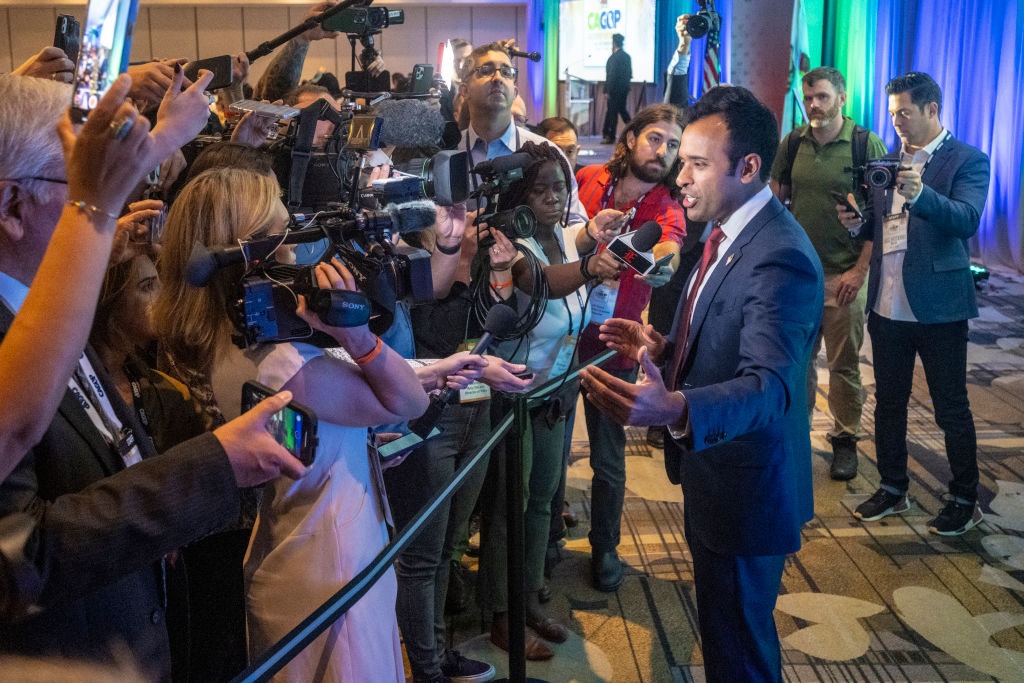What it will take to break the Deep State.
How to Spin a Shutdown

An overhaul of the federal bureaucracy needs a media strategy bold enough to sustain it.
It’s a simple enough request: walk down the street and chew gum at the same time. And yet, Republican officeholders find it immensely difficult. All too frequently, they confuse ethics with tactics—or, put another way, rule adherence with statesmanship.
Lancelot Lamar’s comprehensive two–part proposal to defang the bureaucracy deserves close reading from anyone serving in the West Wing of a future Republican administration. One of its major premises is that, contrary to bipartisan presumption going back decades, the goal in a shutdown of the federal government should not be a return to business as usual or even to “regular order” for its own sake. Instead, the goal of a shutdown must be real reform of how the existing bureaucracy acts, even through an embrace of “irregular order.” This raises natural follow-up questions about what should replace business as usual.
Lamar, the pseudonymous former Trump Administration official, doubtless saw first-hand how shutdown politics gets co-opted to redound toward the priorities of the existing bureaucracy (which may be at minimum three-to-one or as much as nine-to-one more supportive of Democratic politicians than Republican ones as recently as the 2020 election cycle). Just like Charlie Brown with the football, the next Republican administration will be dreaming if it imagines that a shutdown will automatically work in its favor unless it understands what a framework for success resembles.
A smaller and more constitutionally sound bureaucracy is Lamar’s commendable goal. However, flexing executive power in the service of conservative aims is no secondary priority. Quite the opposite. As Professor John Yoo has pointed out about our broken constitutional order, when your car is in a ditch, the first task is to get out of the ditch. Then you drive in the breakdown lane. Then you can get back on the road for normal driving. Getting your car out of the ditch and driving in the unsafe breakdown lane are necessarily not going to involve following the normal rules of the road. However, your goal of leaving the breakdown lane to later merge onto the road gives you ample latitude in determining the precise measures for eventual normal driving.
Executive actions, particularly during a contentious shutdown, will be messy and unprecedented even if legal under Lamar’s proposal. Lamar’s guidance to prioritize executive actions at the agency level that divert existing funding toward core functions, rather than the pet projects of bureaucrats, will necessarily aid conservative ends. That’s where Lamar performs a valuable service: he shows us the ditch we’ve driven into and outlines tactics on how to drive out and navigate the hazardous breakdown lane.
However, it’s not enough to assume that, by following Lamar’s playbook, Republicans embracing “irregular order” will succeed. Walking down the street and chewing gum means not only taking specific executive actions at the agency level, but also telegraphing clearly what is happening and why it is happening. One recalls the criticism of George H.W. Bush, by Robert George, that on pro-life issues Bush was “all action and no talk.” Narrative dominance is the most important piece of Lamar’s proposal. If achieved, it will give cover to wide swaths of his proposals and shift the Overton Window for what’s possible. If unsuccessful, only piecemeal victories during “irregular order” will be won, leaving many to wonder what the fuss was all about.
To win the war of focus and attention, Lamar advocates such policies as media blackouts at each agency in service of the larger aim of starving the media, with the White House serving as the sole source of anything fit for quotation. I am skeptical that the corporate press would be foiled so easily. If anything, recent shutdowns have featured friendly “sources” from within the agencies happily serving the narrative of chaos with selective leaks to the press. A tight-lipped White House may resemble the media on the eve of the Tet Offensive during the administration of Lyndon Johnson. As I learned from Hadley Arkes in his memoir Natural Rights and the Right to Choose (2002), the journalist Peter Braestrup demonstrated in Big Story (1978) that Johnson and his administration did little to explain to the American people directly, much less prepare the corporate media, of the context for the Vietcong’s attack. Those journalists therefore reported only the “direst implications” of an “American defeat.” Braestrup contrasted this treatment of the Tet Offensive with how Richard Nixon and his administration handled the Vietcong’s May Offensive several years later, with Nixon appearing live before the nation to explain in clear terms the situation and the measures American military forces were taking. The Nixon Administration’s policy of candor prevented the media from crafting a narrative of chaos.
Thanks to Twitter/X, it has never been easier or more crucial to offer the masses a detailed, sufficient explanation in real time for why certain actions are being taken. However, that requires embracing the kind of guerilla storytelling practiced by none better than Chris Rufo. Rufo’s great virtue is in telling by showing. He lays his cards on the table, identifying a target and articulating why that target deserves your ire. His near-daily revelations of diversicrat chicanery within the federal bureaucracy led in 2020 to an executive order designed to root out race and sex stereotyping.
Lamar should amend his proposal to draw on a similar kind of approach to narrative warfare during “irregular order.” No shortage of corruption and abuse of the public fisc exists among agencies for the likes of Rufo to make the target of nationwide focus and anger during a shutdown, rather than letting the media conjure the worst fears during a shutdown. A Rufo-esque feature of, say, the most egregious federal programs, and the bureaucrats earning over $250,000 per year to administer them, can have the virtuous effect of worrying even other bureaucrats and client interests. But again, the key is not to fight too broad a battle. Picking targets that are realistically capable of being hit will preserve public support during a shutdown and keep the narrative of sustained success during ongoing negotiations. And in true Rufo fashion, all these battles should be well documented on social media and signaled in real time.
The keys to success in the narrative war as well as in “irregular order” more broadly will be statecraft and prudence. Personnel holding leadership positions during “irregular order” must be fearless and willing to lose their jobs after this major battle and leave the administration. Surely not everyone in these posts can afford to fall back on savings or another job. Some individuals in positions where force multipliers exist should be chosen for this ability to fall on their swords. Lamar doesn’t discuss this in his feature, but patronage networks on the Left provide a tremendous safety net for bold actions that do not always succeed politically. We need more of these, not fewer, on the Right as an auxiliary measure for softening the blow of some inevitable degree of failed courageous actions.
Lamar defines well the problem of administrative rule directed by a hyper-partisan bureaucracy toward anti-constitutional ends. His proposal seeks to bring us out of the ditch and onto the road, even if it rings odd to many a governing conservative ear. It deserves serious consideration, and a media strategy that can plausibly support it.
The American Mind presents a range of perspectives. Views are writers’ own and do not necessarily represent those of The Claremont Institute.
The American Mind is a publication of the Claremont Institute, a non-profit 501(c)(3) organization, dedicated to restoring the principles of the American Founding to their rightful, preeminent authority in our national life. Interested in supporting our work? Gifts to the Claremont Institute are tax-deductible.
What it will take to break the Deep State.
Vivek Ramaswamy makes a valiant but doomed proposal to dismantle the administrative state.



